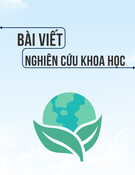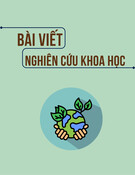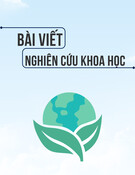
VNU Journal of Science: Earth and Environmental Sciences, Vol. 41, No. 1 (2025) 30-38
30
Original Article
Analyze and Compare the Microplastic Pollution in the Water
Samples at Han River Estuary (Da Nang)
Nguyen Thi Thanh Hoai1, Ta Le Dang Khoi2, Le Trung Son3,
Dang Thi Thom4, Nguyen Bich Ngoc5, Vu Thu Van6, Tran Thi Thu Huong7,*
1Vietnam Institute of Meteorology, Hydrology and Climate Change,
5/62 Nguyen Chi Thanh, Ba Dinh, Hanoi, Vietnam
2Nha Trang University, 2 Nguyen Dinh Chieu, Nha Trang City, Khanhhoa, Vietnam
3Hanoi University of Science and Technology, 1 Dai Co Viet, Hai Ba Trung, Hanoi, Vietnam
4Institute of Science and Technology for Energy and Environment,
Vietnam Academy of Science and Technology, 18 Hoang Quoc Viet, Cau Giay, Hanoi, Vietnam
5Hanoi University of Natural Resources and Environment, 41A Phu Dien, Bac Tu Liem, Hanoi, Vietnam
6 Tomsk University of Polytechnic National Research - Russian Federation
7Hanoi University of Mining and Geology, 18 Vien, Duc Thang, Bac Tu Liem, Hanoi, Vietnam
Received 27th August 2024
Revised 11st November 2024; Accepted 12nd February 2025
Abstract: The aim of this is study to analyze and compare the amount of microplastics in the surface
water and water column samples at Han River estuary (Da Nang) in the rainy season 2023. Sixteen
water samples (eight water column samples and eight surface water samples) were collected and
analyzed to determine the quantity, shape, color, size, and polymer forms of microplastics. The
results showed that microplastics were present in almost all samples and the column water samples
have the tendency of pollution with higher densities. Microplastic pollution between two group
samples was not consistent ranging from 49 to 489 particles/L in surface water and from 95 to 334
particles/L in column water samples. Location DN6 recorded the highest values in both samples
with 489 and 334 particles/L in surface water and column water, respectively. Microfragment
predominates with 60.13% in both samples. Sequently, microfibers observed account for 36 and
33,33%, respectively. The remaining shapes range from the lowest of 0.57% (surface water samples)
to 5.17% (water column samples). The white color predominances and found of 45 and 52.3% for
surface water and water column samples, respectively. The second most popular color is blue,
followed by green, red and several other colors. The microplastic with size in 50-150 μm accounts
________
* Corresponding author
E-mail address: tranthithuhuong@humg.edu.vn
https://doi.org/10.25073/2588-1094/vnuees.5220

N. T. T. Hoai et al. / VNU Journal of Science: Earth and Environmental Sciences, Vol. 41, No. 1 (2025) 30-38
31
for the highest proportion 665 and 715 particles/L, respectively. Similarly, the large sizes in 300 -
500 μm account for the lowest proportion, only reaching total values of 90 and 80 particles/L,
respectively. FTIR results showed that PET (Polyethylene Terephthalate) polymer has the highest
density in both two samples with 750 and 310 particles/L, followed by nylon with values of 140 and
175 particles/L, respectively. The remaining polymers such as Cellophane, Polystyrene standard,
Teflon, Fluoropolymer, Urea fomaldehyde etc., account for a fairly low proportion and it is different
between two groups of samples.
Keywords: Microplastic pollution, Han River estuary, water surface, water column.
1. Introduction
Plastic has become indispensable due to its
characteristics including versatility, low price,
long life, used at a wide range of temperatures,
biologically inert and is very durable. This has
led to plastics being applied in many sections
such as household, personal goods, clothing,
packaging and construction materials. As a
result, global plastic production has increased
exponentially since the mass plastic production
was first implemented in the 1950 s and
increased linear to 288 million tons in 2012 [1].
While a portion of plastic waste is properly
managed and treated (through incineration or
recycling), it is estimated that millions of tons of
plastic waste still exist (4.8 to 12.7 million tons
in 2010) and causes marine environmental
pollution. The waste plastic decomposes into
microplastics that accumulate in water,
sediment, organisms and become a major
hazard, affecting the environment, ecosystem
and human health [2].
According to the US National Oceanic and
Atmospheric Administration (NOAA)
“microplastics are very small pieces of plastic
less than 5 mm in size, which can enter natural
ecosystems from a variety of sources including
cosmetics, clothing, and industrial processes”
[3]. Microplastics are divided into two groups:
primary microplastics and secondary
microplastics. Due to their small size,
microplastics are easily confused with the food
of living organisms [4]. The rivers significantly
contribute to microplastic pollution in the oceans
due to their estuarine directly connection to the
sea. According to MONRE report (2021) it is
estimated that about 80% of marine waste comes
from activities on land in Vietnam [5]. With 112
coastal estuaries stretching from North to South,
it is potential pose the plastic waste to drift into
the ocean and cause many risks affecting to the
quality of the aquatic ecological environment in
the estuary area.
Currently, many studies have been carried
out to assess microplastic pollution but mainly in
marine and coastal sediment [6-8]. Luu et al.,
(2020) recorded an average microplastic
concentration of 22.95 ± 8.9 mg/kg at the tidal
flats of Da Loc commune, Hau Loc district,
Thanh Hoa province, in which microplastics in
the form of fragments, pellets, fibers and films
[6]. Similarly, when decomposing surface
sediment samples of Tien Yen Bay, microplastic
pollution was recorded of 664±68 MPs/kg,
including fragments (8.54%), pellets (4.99%),
fibers (84.9%), films (1.57%) and mainly PE,
PVC, PP, PS, PA groups, etc,… [7]. In addition,
microplastics have appeared in sediments in the
Nhieu Loc - Thi Nghe canal due to plastic waste
discharged into the environment [8]. These
initial studies have provided important
information about the status of microplastics in
the sediment environment in general and the
pollution of MPs in water body in particular.
However, the database in the South-Central
region is still quite limited. Therefore, this study
was condcuted to analyze and compare the
amount of microplastics in the surface water and
column water samples at Han River estuary (Da
Nang) in the rainy season 2023 for assessing the
current status of microplastic pollution in the
water environment, as a database basis for
further scientific research.

N. T. T. Hoai et al. / VNU Journal of Science: Earth and Environmental Sciences, Vol. 41, No. 1 (2025) 30-38
32
2. Methodology
2.1. Sampling Area
Da Nang is the most important city of the
Central region, located in the South-Central
region, Vietnam. This city is one of the centers
about economic, financial, political, cultural,
tourism, social, educational, scientific and
technological. Da Nang city has a geographical
location stretching from 15055' to 16014' North
and from 107018' to 108020' East. Han River is
one of the four main rivers of Da Nang city,
located downstream of Thu Bon River and plays
an important role in the socio-economic
development of Da Nang city. The 8 locations
selected from Tien Son bridge running gradually
towards Da Nang Bay (Figure 1). These are
locations with many waste sources or activities
related to the discharge of plastic and
microplastic waste.
Figure 1. Map of sampling locations at Han River estuary - Da Nang.
2.2. Sampling Method
The process of collecting microplastic
samples in surface water and water column was
based on published methods [9, 10]. Neuston
mesh set (with mesh hole size of 300 µm) was
attached to the water collection box or Manta
trawl net (dimensions D x W x H = 30 x 30 x 15
cm). A flowmeter attached to calculate the
amount of water collected when microplastics
flowed through the net. Sampling devices were
anchored to boats at sampling locations and
water collection boxes were floated on the water
surface to collect all solid objects floating in the
surface water layer and water column including
plastic waste and other types of solids. Neuston
net casting time was from 30 - 60 minutes. The
sample collection time in this study is in the
rainy season of 2023. Samples were stored at
4 °C in dark bottles and transported to the
laboratory the same day.
2.3. Analysis and Statistical Methods
The samples were transported to the
laboratory for analysis (density, shape, size and
color) using a microscope MSZ5000-T-IL-TL,
Kruss (Germany), then a Micro-FTIR system
(Nicolet iN10MX) was used to classify the
polymer forms present in the sample. The
analysis procedure followed the published steps
by Do et al., (2022) [11]. The data in the study is
processed using GraphPad 6 software. The
volume of water will be recorded on the
flowmeter for calculation. Microplastic density
is calculated according to the following formula:
C = n
V
Where is C: The microplastic density
(fragment, fiber, particle/m3); n: Number of
microplastic pieces in the sample (fragment,
fiber, particle); V: Volume of water filtered
through the mesh (m3).

N. T. T. Hoai et al. / VNU Journal of Science: Earth and Environmental Sciences, Vol. 41, No. 1 (2025) 30-38
33
Table 1. Sampling location characteristics
No.
Sampling area
Code sample
Characteristic
1
Tien Son Bridge
ĐN1 (1602'8"B;
108014'8"Đ)
On both sides are residential areas of My An, Hoa Cuong
Bac and Hoa Cuong Nam Ward, Ngu Hanh Son District.
2
Tran Thi Ly Bridge
ĐN2 (1602'58"B;
108013'47"Đ)
On both sides are residential areas, restaurants near the
Green Island villa area and Dinh Tien Hoang primary
school in Binh Thuan Ward.
3
Rong Bridge
ĐN3 (1603'38"B;
108013'38"Đ)
On both sides are residential areas and many restaurants
in An Hai Tay and Hai Chau 1 Ward.
4
Han river Bridge
ĐN4 (1604'19"B;
108013'36"Đ)
On both sides are hotels, restaurants and supermarkets in
An Hai and Son Tra Ward, Hai Chau and Son Tra District.
5
The discharge drain
of city
ĐN5 (1604'47"B;
108013'34"Đ)
This is the discharge point from Da Nang city into Han
River, near Da Phuoc (Old) fishing port and Da Nang
marina in Thuan Phuoc and Hai An Bac ward.
6
Thuan Phuoc Bridge
ĐN6 (1605'39"B;
108013'11"Đ)
This area is near Thuan Phuoc lighthouse, on both sides
are hotels and restaurants, no population, in Thuan Phuoc
and Nai Hien Dong Ward.
7
On the Da Nang Bay
ĐN7 (1606'14"B;
108013'8"Đ)
This area is the intersection of the Han River flowing into
Da Nang Bay, far from Thuan Phuoc bridge (ĐN6) 700 m.
8
On the Da Nang Bay
ĐN8 (1606'1"B;
108012'50"Đ)
This area is far 800 m from ĐN7, on Da Nang Bay and
there is no population.
3. Result and discussion
3.1. The Microplastic Density Classification
by Quantity
The results in Table 2 showed that all 8
sampling locations have the presence of
microplastics, ranging from 49 to 489 particles/L
in surface water and from 95 to 334 particles/L
in column water samples. The lowest
microplastic density was recorded at location
ĐN8 in water column samples and ĐN4 in
surface water samples (49 and 95 particles/L,
respectively). The highest value obtained at
location ĐN6 for both water column and surface
water samples (334 and 489 particles/L,
respectively).
3.2. The microplastic Density Classification in Size
Microplastic samples are classified into 5
size groups including 20-50; 50-150; 100-300;
300-500 and >500 μm (Table 3). The size in 50-
150 μm accounts for the highest proportion of
665 and 715 particles/L, respectively. Similarly,
the large size in 300-500 μm account for the
lowest proportion, only reaching total values of
90 and 80 particles/L, respectively. Location
ĐN6 observed the microplastic density with
values of 310 and 190 particles/L, respectively
(sizes in 50-150 μm). There were no
microplastics in surface water and water
columns in locations ĐN4 and ĐN8,
corresponding to the size 300-500 μm and 150-
300 μm.
3.3. The Microplastic Density Classification in Shape
There are 4 forms of microplastic shape in
both two sample groups at the Han River estuary
(Da Nang) including: fiber, fragment, particle
and other forms. Microplastic fragments were
the most abundant form found in the study area
in both surface water and water column samples
with the highest value of 60.13%. Sequently,
microplastic fibers observed account for 36 and
33,33%, respectively. The difference values also
appear in the remaining two forms, particle and
some other shapes, ranging from the lowest
0.58% (surface water samples) to 5.87% (water
column samples) (Figure 2).

N. T. T. Hoai et al. / VNU Journal of Science: Earth and Environmental Sciences, Vol. 41, No. 1 (2025) 30-38
34
3.4. The Microplastic Density Classification
in Colour
Microplastics colors are very variation
(white, black, blue, green, etc,…). The white
color is the most common and consistently
present in all surveyed locations, accounting for
45 and 52.3% in surface water and water column
samples, respectively. The second most common
color is blue with values of 25.4 and 20.2%,
respectively. Sequently, the green, red and some
other colors recorded corresponding values in
surface water samples as 15.9; 9.4; 4.3% and in
the water column samples are 15.9; 7.1; 4.5%
(Figure 3).
Table 2. Total of microplastics in surface water
(ĐN_NM) and water column (ĐN_CN) samples at
Han River estuary (Da Nang)
No.
Code
sample
Number of microplastic
(Particles/Lit)
ĐN_NM
ĐN_CN
1
ĐN1
50
171
2
ĐN2
220
194
3
ĐN3
49
142
4
ĐN4
49
187
5
ĐN5
108
137
6
ĐN6
489
334
7
ĐN7
92
148
8
ĐN8
144
95
Total
1201
1408
Table 3. The size of microplastics in surface water (ĐN_NM) and water column (ĐN_CN) samples
at Han River estuary (Da Nang)
Code
sample
20-50 µm
50-150 µm
150-300 µm
300-500 µm
> 500 µm
ĐN_NM
ĐN_CN
ĐN_NM
ĐN_CN
ĐN_NM
ĐN_CN
ĐN_NM
ĐN_CN
ĐN_NM
ĐN_CN
ĐN1
10
30
25
80
5
20
5
30
5
20
ĐN2
35
70
110
90
45
20
15
10
20
15
ĐN3
20
40
10
95
5
20
10
15
5
20
ĐN4
15
80
25
70
10
15
0
10
5
25
ĐN5
45
35
35
55
20
25
15
10
5
20
ĐN6
60
115
310
190
55
40
25
5
50
10
ĐN7
20
15
50
95
15
30
5
10
15
5
ĐN8
35
45
90
40
0
10
5
0
25
10
Total
240
430
655
715
155
180
80
90
130
125
Figure 2. Average proportion of microplastic forms (fibres, fragment, particle and other forms) in surface water
samples (a) and water column samples (b) in Han River estuary (Da Nang).



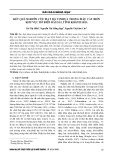
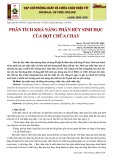

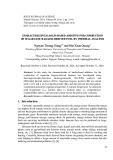

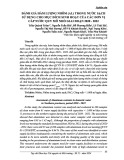
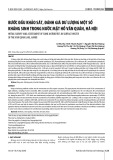

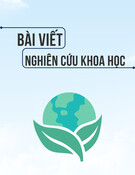
![Tài liệu Vi sinh vật môi trường [Mới nhất]](https://cdn.tailieu.vn/images/document/thumbnail/2025/20251123/ngkimxuyen/135x160/21891763953413.jpg)
![Sổ tay truyền thông Phân loại chất thải rắn sinh hoạt trên địa bàn tỉnh Quảng Nam [Chuẩn nhất]](https://cdn.tailieu.vn/images/document/thumbnail/2025/20251114/kimphuong1001/135x160/1701763094001.jpg)
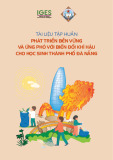

![Quản lý chất thải nguy hại: Sổ tay Môi trường [Chuẩn nhất]](https://cdn.tailieu.vn/images/document/thumbnail/2025/20251029/kimphuong1001/135x160/9011761720170.jpg)




